-
Posts
550 -
Joined
-
Last visited
Content Type
Profiles
Forums
Blogs
Gallery
Events
Store
Posts posted by Brian R
-
-
-
An interesting bar but probably not traceable... The Merit Order-Knight with Swords and Albert-Knight 1st Class with Swords should be a relatively uncommon combination especially given the Oldenburg Friedrich August Cross. But there are no Oldenburg rolls, correct? Probably retired as a Major with some connection between Saxony and Oldenburg.
 0
0 -
-
It looks a little smaller than usual - perhaps a variation.
0 -
Laurens -
Do you have any other docs from this guy? Although your doc could have been awarded as result of the mine laying operations in May, it could also be an award based on Bruno Heinemann's particpiation in the invasion of Trondheim (escorting the Admiral Hipper and unloading troops of 3.Gebirgs-Division).
Here is a doc awarded on the same day as yours - included in the group is an EK2 doc dated April 16, which I'm sure is the result of the actions at Trondheim.
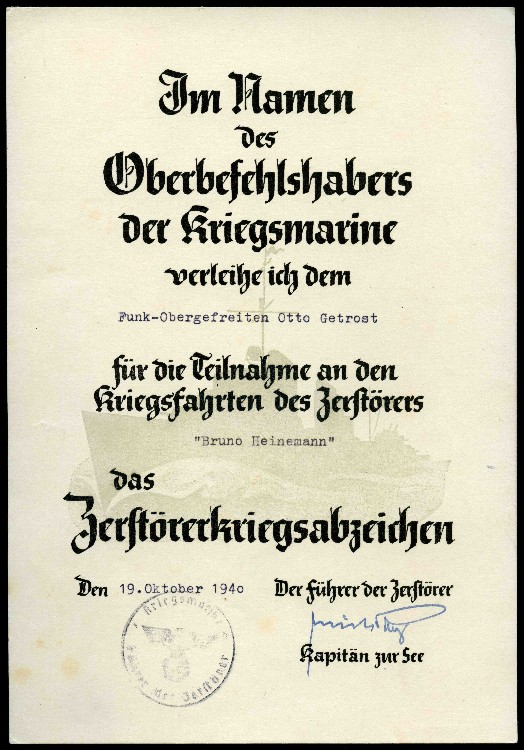 0
0 -
I don't know anything about US WWI items - this seems very reasonable, no?
Compared to German items it is a tenth of the price - is there something wrong with it or are US items that cheap?
http://cgi.ebay.com/WWI-IDED-26TH-DIVISION...1QQcmdZViewItem
I'm no expert on this particlur tunic, but you can get really nice ones for less than $200. It's only a matter of time before they go up...
0 -
Purchased from Chris B. a few years ago...
An EK2 doc to Wilhelm Hafft, awarded on 19 October, 1940 as a crewmember of Vorpostenboot 411. It has a nice, clear signature of Admiral L?tjens who died with the Bismarck in May, 1942.
VPB 411 was built as a whalecatcher in 1934 and was later converted to a VPB. It was part of 4. Vorpostenflottille and stationed in the region off Bordeaux and Bayonne from 1940 to 1944. Although operating on the Atlantic Coast, this award could have been made as a result of heavy action in the period leading up to Operation Sealion.
VPB 411 was sunk on 26 August 1944 in the Gironde ? the result of an Allied aircraft bomb hitting the boiler room.
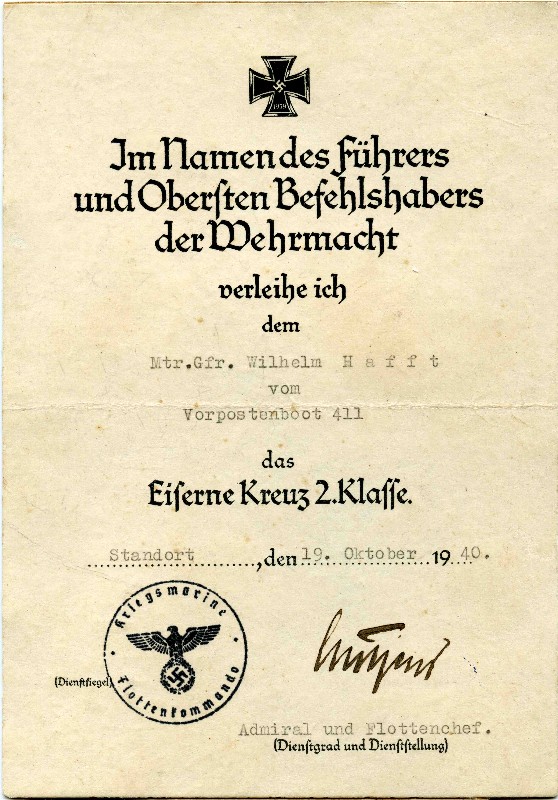 0
0 -
Here's one from the Western Front a month before the end of the war.
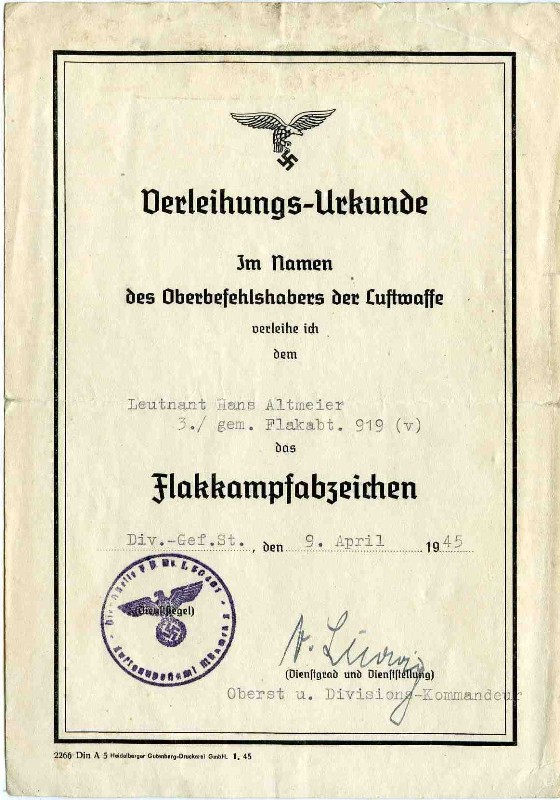 0
0 -
A nice, late war EK1 doc from the waters off northern Norway. I quote from Simon Orchard who generously provided this info a while back...
"Admiral Nordmann?s patch ran from Narvik right up to Petsamo. Troms? was where the admiral had his headquarters and Finnfjorbotn is where that HQ moved to as part of the general withdrawal from Finland and Finnmark\North Troms? and the establishment of the Lyngen line (which Tirpitz was supposed to defend as a floating battery but was sunk in early November). The EKI is without doubt connected to the withdrawal from Petsamo, Kirkenes and East Finnmark. For the Kreigsmarine this was a time of trying to save as much men and material as possible whilst under more or less constant attack from the Russians."
This doc is part of a small group - I have his EK2 doc from September 1943 (in Troms?) as well as EK2 with packet and his cased EK1
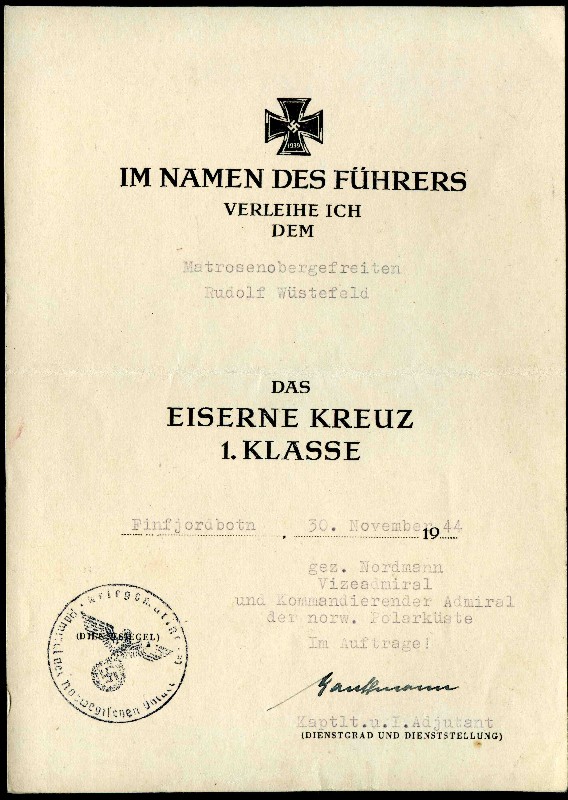 0
0 -
I have this doc to a member of 1. Gebirgs-Sanit?ts-Kompanie 95 of the 5.Gebirgs-Division. Based on the date, I would assume it was awarded as a result of the fighting on Crete. I had figured this unit was part of the "Kleine Schiffsstaffel" during the initial invasion, however a helpful member at the Axis History Forum said its was not (only 2. Gebirgs-Sanit?ts-Kompanie 95 was part of the first groups). Perhaps this unit followed later by plane? Does anyone have any info?
Also, I'm curious about the signature. I cannot make it out (and the corrective tape is an interesting touch). Ringel was the division commander - who was this Oberst signing for him?
 0
0 -
Here's another... awarded to Gefreiten Albert Kleinecke on 20 May, 1940 as a member of 12. (M.G.)/ IR 47 for actions in the area of Den Hague,?Holland. It was signed by Hauptmann and Batl. Kdr. Rudolf Gustav Buhse for Generalleutnant Graf von. Sponeck, commander of 22. Infanterie Division.
Kleinecke was awarded for bravery following his unit?s attempt to secure the airfields north of Rotterdam, in the Hague region on May 10th. IR 47, along with IR 65, air landed in or around Valkenburg, Ockenburg and Ypenburg with varying degrees of success. The two regiments suffered heavy casualties and failed to secure their objectives the first day (including the capture of the Dutch Royal Family and government). They were eventually successful in securing the airfields and Holland capitulated on May 15, 1940
Interesting printed text...
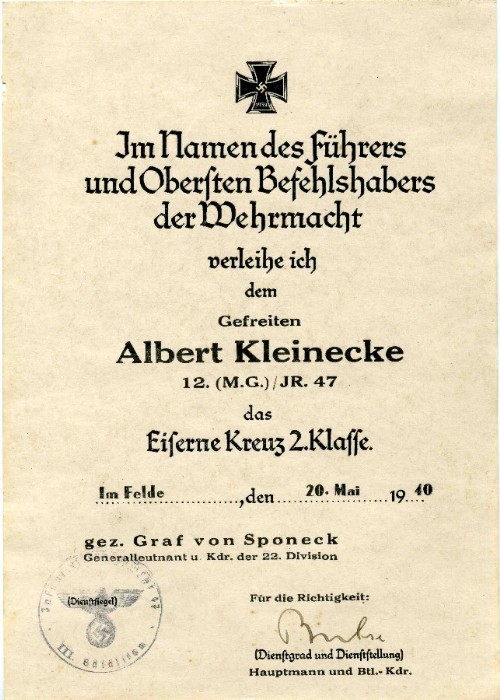 0
0 -
Hi Brian,
How in the world do you have access to that info? That is very impressive.
Jay
Jay - Besides my interest in militaria, I have been studying my famly history too. WWI Registration info is available on Ancestry.com. A subscription is needed to get the info, but I'd gladly search the site for anyone who is interested in a specific soldier. It's not always guaranteed but it's worth a try...
0 -
Looks almost like a parts bar (new ribbons, old medals) and I would imagine the HC and War Aid Cross should be switched.
0 -
Here's one to a Friedrich Ihn crew member who could have qualified for his badge on the same mission. It is tough to say though, as he won his EK2 in January, 1940. He could have won it for any earlier mine laying mission etc., and received his destroyer badge in the months after its ultimate creation.
 0
0 -
Great group, Gordon!! Can you tell me what MPA means on the EK2 doc?
Also, Rick, how do you know this? Very interesting...
The file reference number on the bottom left of that EK document appears to indicate that the award was classified secret. 0
0 -
Great information, Paul. I knew the wartime awards should have come first, but I didn't know about the general rule concerning the the KO3X (KO4X) and China/SWA medals. :beer:
0 -
Here's another...
 0
0 -
Paul - This truly is a great thread - Thanks for starting it and providing such great explanations.
The problem I have with understanding medal bars is this (at the risk of showing how ignorant I really am)...
How do bars from various states end up on the same bar? I understand that soldiers were transferred, and units from one area served with others but... here's an example...
Here is a post 1934 frack bar to a Saxon who refused to follow regulations; wearing his Albert Order before the EK. He has to be at least a Leutnant. The Brunswick Cross is an EK equivilant, but has been awarded to a Saxon.
Is this a Saxon officer serving with a unit from Brunswick? Is it a man from Brunswick serving as a Saxon officer? Or what? And how does it relate to his Saxon Landwehr Service Medal?
Part of the problem is that I don't have a good enough understanding of how units from various States merged etc., into the Kaiser's army.
Thanks, as always.
 0
0 -
navy officer?
Perhaps. How high could his rank possibly be given the RAO 4th Class? Kapit?n?
0 -
-
I picked this bar up within the last year from Heiko - not sure if he ever showed it off.
A bar to a Captain or Major who served from the late 1800s through the mid 1930s... he wears the ever interesting Black/White EK with Non Com HC combo as well as the bronze China-Denkmunze with FAUPING bar. The award at the end is, I think, a Weimar era DRK award. I am curious as to why he would wear this medical service award as compared to any other, especially given his rank and long career. Comments and feedback?
Posted in the wrong forum - perhaps a moderator can move it up? :cheers:
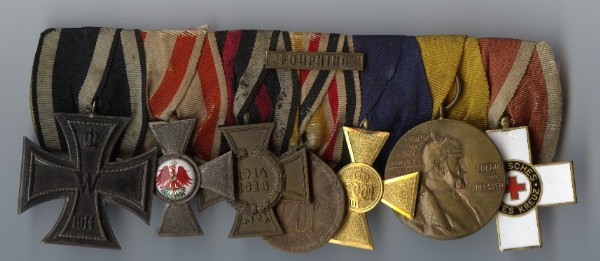 0
0 -
He looks like the Last Surviving Napoleonic Veteran.

That appears to be a lionhead hilt on his sword, so it's his old "honor weapon" from army artillery or cavalry days, I think.
Photo must be from before the Polizei long service awards of 1938 were bestowed, and from his service in 1897 but only an XV, he must have left as a senior NCO BEFORE the First War and ? was already in the Police then-- possibly mobilized as a Feldgendarme in 1914. If he'd had continuous military service he would be wearing a Prussian XXV Years Service Cross.
FORTY years to claw his way up to some sort of Oberleutnant equivalent....

Excellent, Rick. Thank you!!
0 -
both pages...
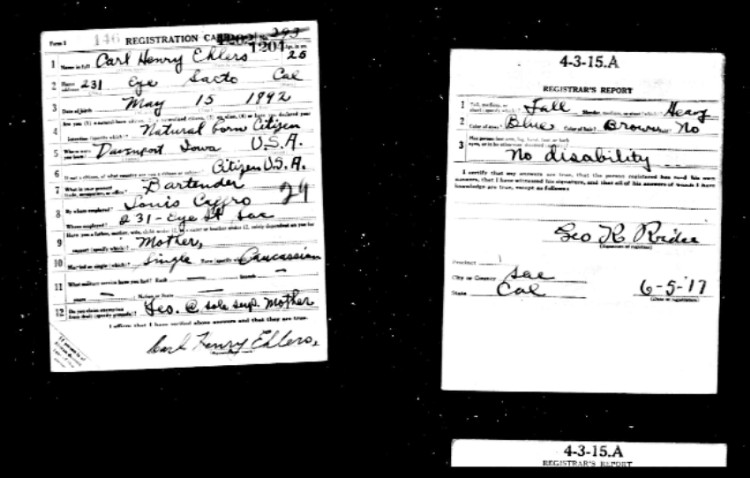 0
0 -
Here's his Draft Registration Card. He was born in Iowa but registered in California. He was a bartender before the war and tried to claim an exemption based on his being the sole supporter of his mother.
 0
0




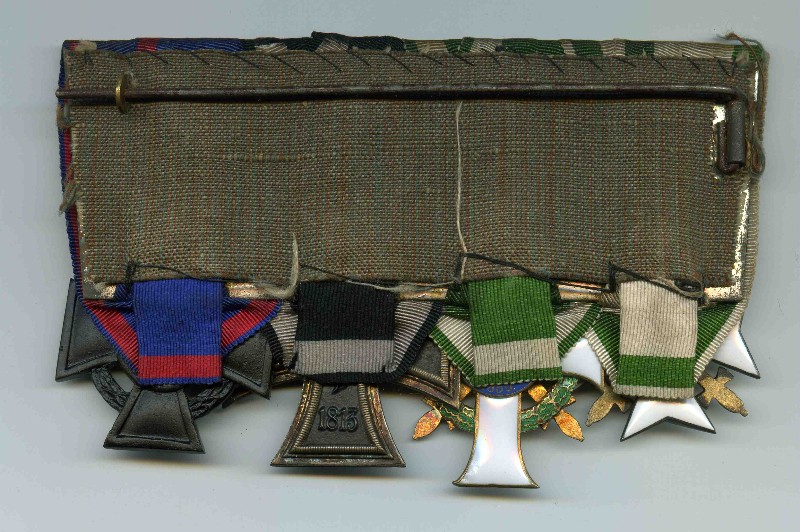
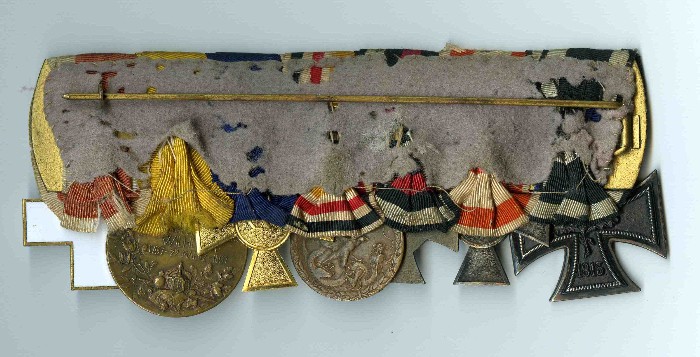
Saxon Medal Bar with Merit Order
in Germany: Imperial: The Orders, Decorations and Medals of The Imperial German States
Posted · Edited by Brian R
Guys - thanks for the feedback. With this type of bar (especially given the frayed ribbon and exposed hooks) it is certainly feasible that the wrong Albert Order is on the bar (no need to hope for a possible explanation). It's funny that the wrong medal is of the higher grade - usually when bars have been switched, the one of lesser value is added as a replacement.
Brian